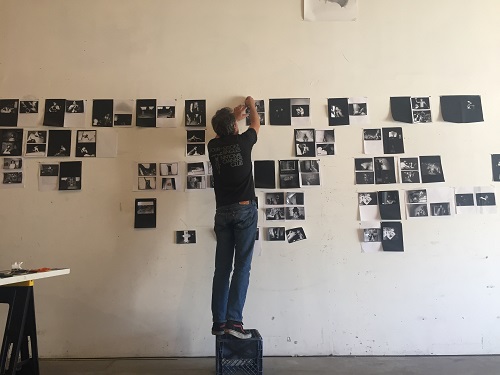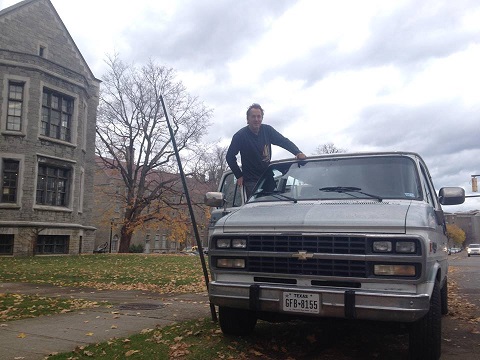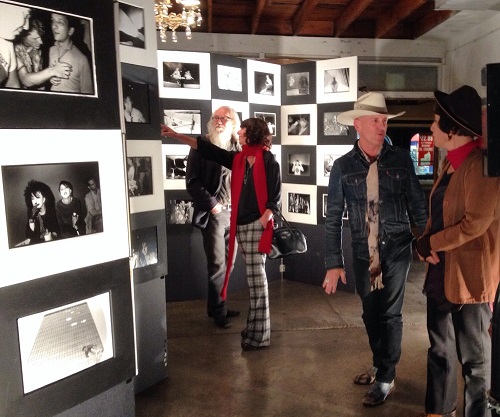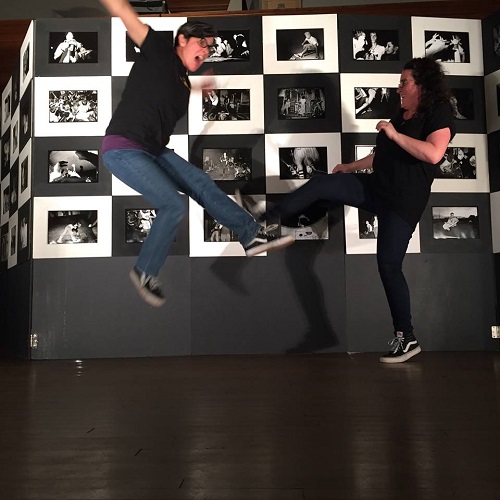by Tara Nelson
More Bill Daniel at Other Cinema’s STREET ART show, 4/23!
Interview with Bill Daniel
If your town has had a thriving experimental art, music, film or photo scene in the past 30 years, chances are Bill Daniel’s van was parked nearby at some point. A self described ‘hobo filmmaker/phototramp’, Bill has been touring the US for three decades, loading up his van with 16mm projectors, reels of films, and milk crates full of photos, books and ‘zines that he either made himself or swapped with artists in towns along the way. I met Bill in 2005 in Pittsburgh, PA. He was touring with his film, Who is Bozo Texino?, a one of a kind documentary/memoir chronicling his experience riding trains and studying the traditions, myths and makers of
hobo graffiti. Bill was already a friend of just about all the artists and filmmakers I knew in Pittsburgh, where his previous visits were legendary; people still talked about watching his films projected on the “sail van” -‐ a large, handmade canvas sail mounted to the top of an orange ’65 Chevy van parked in front of Garfield Artworks on Penn Ave. A few years later Bill was back, settling down in Braddock, PA, throwing bonfire parties on the bank of the Monongahela River. A Texas native, Bill has settled among creative communities from San Francisco to Shreveport, participating in local scenes while documenting the noise going on around him with his 35mm camera. His forthcoming book, Tri X Noise, chronicles his experiences with skate, punk, graffiti and other counter-cultural movements from 1980-‐2015, all captured on black and white Tri X 35mm film. I talked to Bill during his recent visit to Visual Studies Workshop in Rochester, NY, where he presented a one-‐night pop-‐up exhibition of original photos from Tri X Noise, while local bands provided some noise of their own.
Tara Nelson: The book spans 30 years of your life, and documents your experiences living and travelling throughout the United States, starting in Texas, going to LA, San Francisco, Shreveport LA, Braddock PA, Slab City CA, and New Orleans. It really represents your personal journey and experiences with creative counter-culture in America over three decades. And in the background of it all is the great white - or blue - van.
Bill Daniel: I’m really excited to have a new van to travel in because it used to be this old orange ’65 Chevy, which I still have. It’s covered in graffiti and is now the bedroom at the studio, just parked in the shop. Now I’ve got this new ’92 Chevy conversion van with really nice electric seats.
TN: The Tri X Noise project is a result of your experiences with what you describe as “touring culture”. Where does your touring experience start, and how does it show up in the book?
BD: It all starts, like so many stories, with punk rock. It sounds like a cliché, but personally, that’s where it all begins for me. I started seeing punk shows in Austin, and what really made an impression were the touring bands. Bands would come from New York or especially California, and you would get the news because people brought it to you. It goes without saying that this is all pre-internet, so news travelled more slowly,and there was so much less of it. When you heard that there was this new band, or your favorite band that you have only heard of but you have never actually heard…imagine a band that you are completely into but you have never heard their music, because you haven’t got their record because they haven’t brought it yet.
TN: That explains a lot about the photos too. They are these flashes of energy captured in what I imagine to be these tiny back rooms, wherever the punk scene was happening at the time. You see a bunch of kids totally energized to see this band they have heard all about, and everything is just exploding. It’s a great place to start. When did the documentation start for you, and how did that come about?
BD: Around ’79 I took a couple of art classes. I was a business major but I took a couple of electives. I always loved photography but I didn’t really have any aptitude for it, other than the craft itself. But I was going to a lot of shows, seeing a lot of bands, and that was the inspiration. Throughout my whole practice, music has always been the guiding light, so there is definitely an analogy between the Tri X Noise work and the music - the form, the energy, the reduction, the minimalism, the patterning. At those early shows there was always this anticipation that you were going to see a band that you hadn’t seen yet, or maybe you had just seen some blurry pictures in a ‘zine or something. So I would be there with the camera, in a sense ready to perform myself. A lot of us were straight edge at that point, so we would go to shows with a really strong sense of purpose, and I would just wait on the side of the stage, flash in one hand, camera in the other. The band would tune up and I’d be double checking the power on the flash, and then BOOM they would start, and I knew I had about 45 minutes, so I’d just try to get up to speed as quick as possible.
TN: What bands do we see in the photos?
BD: Most of the bands that were touring around ’82, that was a big year for me. Hüsker Dü, The Dead Kennedy’s, Bad Brains…But for my friends and me the bands that made the biggest impression were probably Black Flag and Minor Threat. They were the ones that really influenced us, and launched a lot of local bands. And they were the most fun to shoot because there was a lot of audience participation. Band shots are hard, though, and I wasn’t really interested in just getting band shots. The hardest thing to do is get a shot of a band with everybody in it looking good. That was not something I was going to try to do.
TN: You did get some great band shots, but the beauty of Tri X Noise is in the shots of the crowds, the boots flying, the fists in the air, the screaming faces. The participatory nature of punk is so forcefully present in those images. And that’s much more gratifying, especially now that we can look at pictures of Minor Threat on the Internet whenever we want, but what we don’t get to see is who was there, and see the energy that the crowd was bringing. Your pictures are all about the audience.
BD: That’s definitely something that punk taught: the audience is what’s important. There was this democratization about it, where the band and the audience were really on the same plane, you know, playing on the floor or on small stages. Punk is anti-authoritative in both message and form. So right off I felt that was important to get. And the continuation of Tri X Noise is like that too. If you go through the book, you’ll see a lot of people who aren’t famous outside of their own scenes, and some people will pick it up and say, “Oh my god, there’s Jimmy Shotwell!” Most people won’t know who he is, but he’s no less important
than Ian MacKaye in the role that he played in his scene in San Francisco.
TN: So the book travels from the punk scene in Texas to the graffiti scene in San Francisco…
BD: The book grew out of a series of projects that I have been doing with this vintage material from ‘80-‐’84, but about 10 years ago I started shooting in this style again, using the same tools. There is a gap in the project, because I was making films, shooting Super 8 and 16mm, and in ’84 I stopped going to shows, stopped skating, and stopped shooting skating. So if I chapterized the book, all of that would just be the first chapter, those four years when I was in my early 20’s. And then, like everybody who grew up in the middle of the country, I reached that point where I had to decide if I was moving to New York or San Francisco.
TN: And what did you decide?
BD: San Francisco, for sure. In the late 80’s through the 90’s I was participating in the punk, experimental and avant-garde film scene in San Francisco, which really centered around Artists’ Television Access and Craig Baldwin’s Other Cinema program – which is still running, of course, 30-‐some years later. I moved to San Francisco in 1987 and started working with Craig right away. He was beginning work on Tribulation 99, which I did some re-photography and sound work for. At that point he was re‐tooling his various exhibition projects into Other Cinema, which was a weekly series. I helped with Other Cinema from the beginning. One of the first tasks Craig gave me was to help make an Other Cinema logo out of human hair-‐ his own! I’m sure that was some sort of occult induction into the netherworld of experimental cinema. Luckily the book has some photos from that era, though I wasn’t shooting a lot of stills. I think this happens to a lot of people: when you’re having the most fun you’re not documenting because you are so engaged. I did end up with some pictures of people from that scene, though. About halfway through, the book arrives in California, and then progresses to the contemporary work, up to now.
TN: You have talked about Tri X Noise as a personal scrapbook, not necessarily dedicated to documenting a particular subject or space, but to following your own life and the things going on around you. You move around a lot, and it seems that you are always pursuing – and participating in – some sort of contemporary counter-culture movement, and looking for the environment that supports that movement. So the book is really a document of that journey, starting with punk shows in Texas and somehow ending up in the rust belt landscape of Braddock Pennsylvania.
BD: Yeah, so there you see some wrecked buildings, and wrecked buildings means you have found a place to move to where some people have bought houses, found cheap spaces to start clubs, and are starting a scene. From a reportage point of view that represents the background of where things are happening. So maybe it’s a documentary book, but maybe it’s just a visual sketchbook. I’m not really a documentarian in the traditional sense. A lot of what I end up shooting has to do with having found some time and energy around something that is going on, and actually having the camera there. It’s catch-‐as-‐catch-‐can, so in a lot of ways it’s more of a sketchbook. The layout of the book I did in my studio with Xerox prints, pinning them to the wall to make the sequence and page layout. The design and type is being handled by the same design team that did my other book, Mostly True (Microcosm Publishing, 2008) ‐ Gary Fogelson and Phil Lubliner who now run a design shop in Brooklyn called Other Means. They are brilliant. So far I’ve had a lot of help working on the book, the website, and on a couple of tours from assistants Lila Lee, Nikki Greene, Beau Patrick Coulon, and skate witch Abby Banks, who tours constantly and did a killer book called Punk Houses.
TN: And the title, Tri X Noise, references the type of film you are using, and the “noise” being
the noise of the grain in the image, but also…
BD: “Noise” is kind of the organizing idea for the project. Visually, it’s the noise of the grain of the stock that I love so much, but also the noise of resistance culture, and the noise of the music that is documented in the work.
TN: And you are back in the van, touring with the original photos?
BD: Yeah, I’m touring with a pop-‐up wall, which was inspired by seeing bands travel, taking all their gear city to city. I’m doing that with photography. For a long time I tried to travel with photo shows to put up on walls at the places, but their walls would have something on them already, or there was conduit or windows, so finally I built these pop-up walls out of foam core panels that free-stand in a room, so it sets up an afternoon and breaks down that night, then and you can go on. The book will be out this spring, and I’ll be touring with it and the photo installation this summer and fall. After all this work, and fixing up a new van, I plan to hit the whole country before it’s done. So if you have a space that’s at least 25’x40′, an opening band or two, and a loyal audience for your space, gimme a call! Let’s throw a show!




